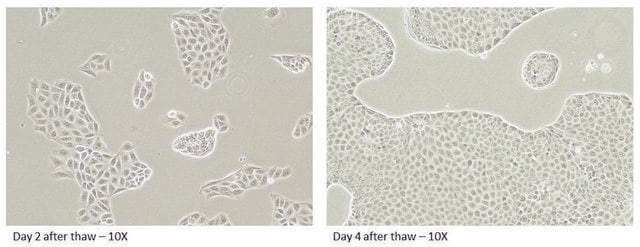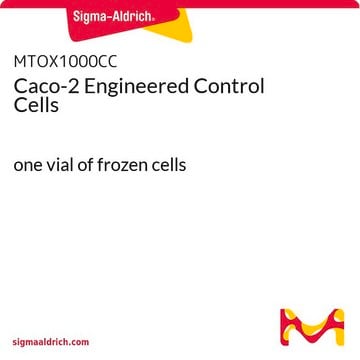MTOX1004P24
MDR1/BCRP Double Knockout Caco-2 Cells
human cervix, Epithelial
Synonyme(s) :
MDR1/BCRP Double Knockout C2BBe1 Cells
About This Item
Produits recommandés
product name
MDR1/BCRP Double Knockout Caco-2 Cells, one assay ready, 24 well plate
Source biologique
human colon
Forme
solid
Morphologie
Epthelial
Technique(s)
drug transporter assay: suitable
permeability assay: suitable
Application(s)
ADME/TOX
Vous recherchez des produits similaires ? Visite Guide de comparaison des produits
Description générale
The three week production lead time begins on the Monday following a purchase, in the third week the plates are shipped on Tuesday for receipt on Wednesday or Thursday. As a biologic product that′s shipped at room temperature the cells must be processed immediately upon receipt.
Application
Transporter Function in Caco-2 Cells with Targeted P-Glycoprotein, MRP2 and BCRP Gene Knockout Using Zinc Finger Nucleases
Comparison of Function and Relative Transporter Protein Concentrations in Caco-2 Cells with Single and Double Knockouts of the ABCB1, ABCG2, and ABCC2 Genes
Caco-2 Transporter Knockout Cell Based Assays
Caractéristiques et avantages
- Functional knockout of the MDR1 and BCRP genes eliminates the reliance on chemical inhibitors to determine if a compound is an MDR1 or BCRP substrate
- The 24 well Transwell format enables the MDR1/BCRP knockout cells to be included in standard drug transporter protocols
- Human assay with no interference from animal inhibitors
- Overcome the limitations of RNAi and knockdown cell lines that arise from remaining transporter functionality
Produit(s) apparenté(s)
Code de la classe de stockage
13 - Non Combustible Solids
Classe de danger pour l'eau (WGK)
WGK 3
Point d'éclair (°F)
Not applicable
Point d'éclair (°C)
Not applicable
Certificats d'analyse (COA)
Recherchez un Certificats d'analyse (COA) en saisissant le numéro de lot du produit. Les numéros de lot figurent sur l'étiquette du produit après les mots "Lot" ou "Batch".
Déjà en possession de ce produit ?
Retrouvez la documentation relative aux produits que vous avez récemment achetés dans la Bibliothèque de documents.
Articles
Application note on Drug transport assays in a 96-well system using Millicell-96 System from Millipore.
Utilize these Caco-2 cell based assay tools for screening small molecule drug compounds prior to clinical studies and submission to regulatory agencies.
Notre équipe de scientifiques dispose d'une expérience dans tous les secteurs de la recherche, notamment en sciences de la vie, science des matériaux, synthèse chimique, chromatographie, analyse et dans de nombreux autres domaines..
Contacter notre Service technique







